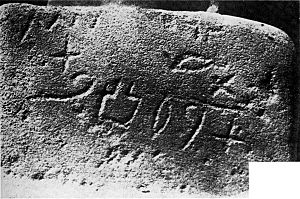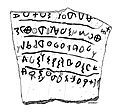Proto-Sinaitic script facts for kids
Proto-Sinaitic is a very old script from the Middle Bronze Age. It is known from only a few writings found in the Sinai Peninsula, especially at a place called Serabit el-Khadim.
Because we don't have many examples of Proto-Sinaitic writing, we aren't completely sure how it worked. This script was used at the same time as Egyptian hieroglyphs. So, it was probably a true way of writing. Many experts believe Proto-Sinaitic was an alphabet. They also think it was the ancestor of the Phoenician alphabet. Most modern alphabets, like the one we use today, came from the Phoenician alphabet.
Contents
Discoveries of Proto-Sinaitic
Two main discoveries have helped us learn about the Proto-Sinaitic script.
First Discovery
The first discovery happened in the winter of 1904–1905. It was found in Sinai by Hilda and Flinders Petrie. These writings are thought to be from around 1700–1400 BC.
Second Discovery
The second discovery was made more recently in 1999. John and Deborah Darnell found it in Middle Egypt. These writings are dated to the 18th century BC.
How Proto-Sinaitic Connects to Other Alphabets
Many experts believe Proto-Sinaitic is the ancestor of many alphabets we know today. The table below shows how some Proto-Sinaitic signs might be connected to letters in the Phoenician alphabet. From Phoenician, many other alphabets like Hebrew, Greek, Latin, and Arabic developed.
| Proto-Sinaitic | Phoenician | Phoen. sound | Phoen. name | Hebrew | Greek | Brahmi | Latin | Cyrillic | Arabic |
|---|---|---|---|---|---|---|---|---|---|
 |
 |
ʼ | ʾalp "ox" | א | Α | A | А | ا | |
 |
b | bet "house" | ב | Β | B | Б, В | ب | ||
 |
 |
k | kaf "palm" | כ | Κ | K | К | ك | |
 |
 |
m | mem "water" | מ | Μ | M | М | م | |
 |
 |
ʻ | ʿen "eye" | ע | Ο | ? | O | О | ع |
 |
 |
r | roʾš "head" | ר | Ρ | R | Р | ر |
Images for kids
See also
 In Spanish: Alfabeto protosinaítico para niños
In Spanish: Alfabeto protosinaítico para niños




